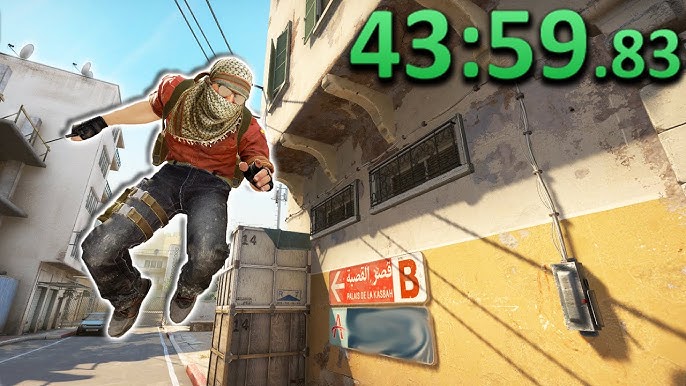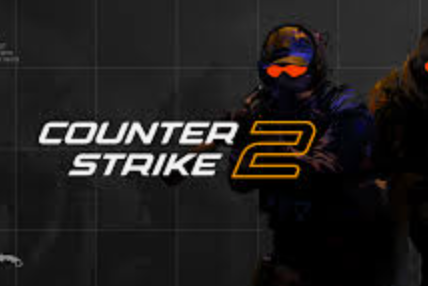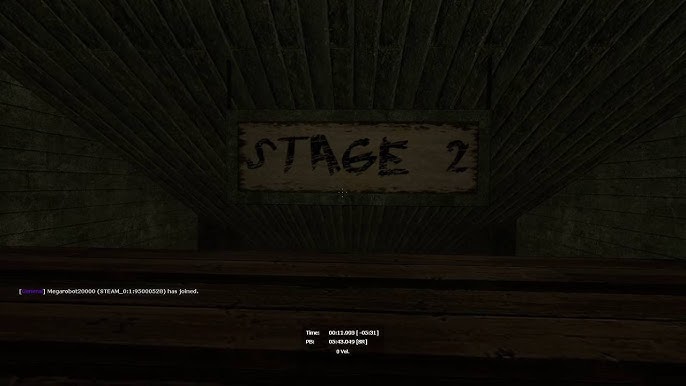Beyond the Bunny Hop: How Counter-Strike: Source Surf Maps Trained Counter-Strike 2 Esports Strategists As a Counter-Strike 2 esports coach, I spend countless hours analyzing team movements, refining rotations, and strategizing map control.

As a Counter-Strike 2 esports coach, I spend countless hours analyzing team movements, refining rotations, and strategizing map control. But my understanding of these intricate facets of the game wasn't forged solely in the heat of competitive matches. Surprisingly, my strategic foundation was built on the slippery slopes and gravity-defying physics of Counter-Strike: Source surf maps. What might seem like a frivolous distraction was, in fact, a crucial component of my development as a player and, subsequently, as a coach. The core skills I honed in those seemingly carefree hours on surf servers translate directly into advanced tactics in today's Counter-Strike 2 landscape. This is the story of how a physics playground shaped my approach to the tactical chess match that is competitive Counter-Strike.
Section 1: "Sliding into Counter-Strike: My Accidental Education"
My journey into Counter-Strike began, like many others, with Counter-Strike: Source. I was captivated by the game's realism, the precision aiming, and the tactical depth. But as a young, somewhat restless player, I was always searching for new ways to push the boundaries of the game’s mechanics. It was during one of these explorations that I stumbled upon the vibrant and bizarre world of surf maps.
Surfing, in Counter-Strike, isn't about riding waves. Instead, it involves using angled surfaces, or "ramps," to gain speed and navigate maps by strafing and controlling your momentum. The ramps are specifically designed to have minimal friction. This allows players to achieve incredible speeds and perform acrobatic maneuvers that defy the game's normal physics. Essentially, you're sliding and flying through the air, using precise movements to maintain your trajectory and avoid falling.
My early experiences were a comical series of falls and near misses. I distinctly remember the immense frustration of constantly sliding off the ramps, unable to grasp the fundamental principle of strafing to maintain momentum. But with each failed attempt, I gained a deeper understanding of how the game's physics engine worked. There was a unique satisfaction in finally mastering a difficult sequence or completing a map for the first time.
Two maps stand out vividly from those early days. The first was "surf_mesa".
Its wide, open ramps and the almost blinding desert skybox created a sense of freedom and exhilaration. I still remember the moment I completed "surf_mesa" for the first time without falling. It was a small victory, but it solidified my determination to master the art of surfing. The other map, "surf_utopia", presented a different challenge. Its sleek, futuristic design demanded pure speed and precision. "surf_utopia" forced you to maintain near-perfect strafes to avoid slamming into walls at high velocity.
Section 2: "The Physics Playground: Mastering Movement and Momentum"
Surf maps are more than just pretty visuals and a fun distraction. They are a unique physics playground that forces you to internalize concepts like momentum conservation, the manipulation of gravity (within the game's engine, of course), and precise air control. These principles are subtly present in standard Counter-Strike movement, but they are amplified and exaggerated in surfing, making them far more apparent.
Normal Counter-Strike movement relies on friction to stop and start, making changes in direction grounded and somewhat predictable. Surfing removes most of that friction. Momentum carries you forward with incredible force. This makes it harder to stop and means your trajectory is dictated by tiny mouse movements. It's an entirely different way of interacting with the game world.
As I progressed, I began to explore advanced techniques like airstrafing – using precise mouse movements in the air to subtly influence your trajectory. Then, there were edgebugs. Airstrafing allows incredible control, even more than surfing on the ground. The real mastery, however, came with understanding edgebugs. They involve exploiting collision glitches for sudden, almost instantaneous speed boosts. And finally, the teleports. Certain maps incorporated teleports which required frame-perfect timing and spatial awareness to execute properly.
Mastering these techniques wasn't just about bragging rights on a surf server. It drastically improved my overall game sense and reflexes. Surfing forces you to react instantly to changing environments. One moment of hesitation or a slight miscalculation could send you plummeting to your death. This constant demand for split-second decisions translated directly into faster reaction times in standard Counter-Strike matches.
Playing surf maps fundamentally changed my understanding of the entire Counter-Strike movement system. I began to predict and control my character's momentum with far greater precision. I could anticipate how my character would react to various surfaces and adjust my movements accordingly.

Specific maps were particularly instrumental in developing these skills. "surf_ninja," for example, with its complex series of jumps and tight corners, demanded perfect airstrafing to navigate successfully. Maps with intricate teleport challenges honed my ability to visualize complex spatial relationships and execute precise timing.
These skills weren't just confined to surf maps. I found myself using strafing to peek corners quickly and efficiently in competitive matches. The mouse control and precision needed for airstrafing helped me better manage recoil by subtly countering the spray pattern. Even bunny hopping, a fundamental movement technique, became more fluid and controlled thanks to the lessons I learned on the slippery slopes of surf maps.
Section 3: "Spatial Awareness: Mapping the Mental Landscape"
Beyond the mechanics of movement, surf maps had a profound impact on my spatial reasoning skills. Navigating these intricate three-dimensional environments required me to develop the ability to visualize complex layouts in my mind's eye.
Meticulously memorizing surf map layouts and planning routes became second nature. This translated directly into an improved ability to navigate Counter-Strike maps effectively. I developed a mental map of each competitive map, allowing me to anticipate enemy movements and predict their positions based on the map geometry.
In surfing, you're constantly predicting and reacting to the terrain ahead. This trained me to anticipate enemy movements in Counter-Strike. By paying attention to sound cues and understanding common player tendencies, I could often predict where an opponent would be before they even appeared on my screen.
This heightened spatial awareness allowed me to quickly assess combat situations and make split-second decisions based on my comprehensive understanding of the map layout. This split-second advantage could be the difference between winning and losing a crucial engagement.
These refined skills have proven invaluable in my role as a coach. I can confidently call rotations and execute complex strategies, knowing that my understanding of the map and the potential movements of both my team and the enemy is based on a solid foundation.

For example, on Mirage, I can anticipate a T-side push through Window based on the timing of the round and the enemy's previous actions. On Inferno, I can predict when CTs are likely to rotate from Banana based on sound cues and the bomb timer. These are just two small examples of how my surf map experience directly informs my strategic decision-making in Counter-Strike.
Section 4: "From Surf Server to Strategy Board: The Coaching Connection"
My experience with surf maps revolutionized my approach to coaching. It's not just about aim duels and grenade timings; it's about understanding the flow of the game and manipulating space to gain an advantage.
I actively leverage surf map techniques and principles to teach players about fundamental movement, effective positioning, and dynamic spatial awareness. It's become a core part of my team's training curriculum.
I strategically incorporate surf maps into our training regimen to improve players' reflexes, decision-making abilities, and overall game sense. It's a unique and effective way to challenge them and push them beyond their comfort zones.
One drill we use, directly inspired by "surf_ninja," focuses on quickly clearing corners using strafing and pre-aiming. The quick reactions and precise mouse control required on that map translate perfectly into aggressive corner peeks in competitive matches. We also use surf maps to practice controlling momentum while rotating around the map, focusing on minimizing travel time without sacrificing accuracy.

The enhanced visualization and spatial reasoning skills that I honed on surf maps allow me to craft effective and innovative strategies for my team. I can see the game from a different perspective. It provides a competitive edge. I can anticipate enemy movements, predict their rotations, and create opportunities for my team to exploit.
Section 5: "The Legacy of the Slide: Surfing into the Future of Esports"
The enduring appeal of surf maps is a testament to their creativity and their impact on the Counter-Strike community. They are a unique form of expression, a way for players to showcase their skill and ingenuity. But beyond the fun and the spectacle, surf maps remain an invaluable training tool for aspiring Counter-Strike players.
While often overlooked, surf maps offer a unique and powerful method for enhancing crucial skills. They teach you to think differently about movement, spatial awareness, and reaction time. The lessons learned on these seemingly simple maps can have a profound impact on your performance in competitive Counter-Strike.
For young, ambitious players who are serious about improving their game sense and spatial reasoning skills, I highly recommend exploring the world of surf maps. Start with classics like "surf_mesa" and "surf_utopia" to learn the fundamentals. Then, challenge yourself with more complex maps like "surf_ninja" to hone your airstrafing and precision. Practice consistently, and focus on understanding the underlying physics of the game.

In a world of modern games often prioritizing realism and simplified physics, surf maps offer a unique and almost archaic form of physics-based movement training. They serve as a reminder that sometimes, the most unexpected and seemingly frivolous game modes can have a transformative influence on professional-level esports skills. My journey from the surf server to the strategy board is a testament to that fact. It demonstrates the unique path from seemingly simple physics-based movement training to strategic dominance in esports.